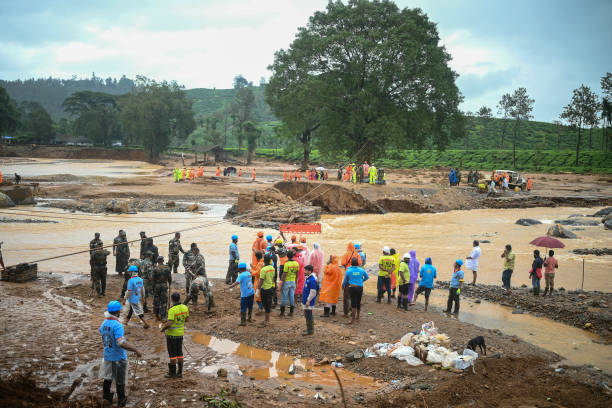Omanyano ovanhu koikundaneki yomalungula kashili paveta, Commisiner Sakaria takunghilile
Veronika Haulenga
Omanyano ovanhu koikundaneki yomalungula kashili paveta, Commisiner Sakaria takunghilile
Veronika Haulenga
Listeners:
Top listeners:
-
play_arrow
Omanyano ovanhu koikundaneki yomalungula kashili paveta, Commisiner Sakaria takunghilile Veronika Haulenga


Indian rescue crews scoured mud-caked tea plantations and villages Thursday with little hope of finding more survivors from successive landslides that killed around 200 people.
Days of torrential monsoon rains have battered the southern coastal state of Kerala, with blocked roads into the Wayanad district disaster area complicating relief efforts since Tuesday.
The number of fatal floods and landslides in India has increased in recent years and experts say climate change is exacerbating the problem.
Army teams were working around the clock to build a temporary bridge over raging waters to help search efforts after earlier relying on jury-rigged ziplines to transport bodies that had been recovered.
Saraswathy, one of hundreds of labourers on the tea estates struck by a wall of mud before dawn on Tuesday, said she had been unable to contact her sister and niece in the days since.
“After this many days, we’ve lost hope,” Saraswathy, who goes by one name, told AFP.
“I came back from the hospital, I kept looking for their bodies but couldn’t find them,” she said. “Eventually I couldn’t stand it. Seeing all these bodies, I almost fainted.”
Wayanad is famed for the tea estates that crisscross its hilly countryside and which rely on a large pool of labourers for planting and harvest.
Brick-walled row homes built to accommodate seasonal workers were inundated by a powerful wall of brown sludge as labourers and their families slept.
The bodies of at least 176 people had been recovered from the disaster site by Thursday, the office of Kerala revenue minister K. Rajan said.
But the final toll is certain to rise, with rescuers reporting the gruesome discovery of dozens of body parts recovered from flood waters or found buried in the muddy earth.
Monsoon rains across the region from June to September offer respite from the summer heat and are crucial to replenishing water supplies.
They are vital for agriculture — and therefore the livelihoods of millions of farmers and food security for South Asia’s nearly two billion people — but also bring regular destruction.
At least 572 millimetres (22.5 inches) of rain fell in the two days before the landslides, according to state chief minister Pinarayi Vijayan.
“The rainfall pattern is changing in recent years with a higher frequency, intensity and spread of high rainfall events,” environmental expert Himanshu Thakkar of the South Asia Network on Dams, Rivers and People told AFP.
Damming, deforestation and development projects in India have also exacerbated the human toll.
India’s worst landslide in recent decades was in 1998, when rockfalls triggered by heavy monsoon rains killed at least 220 people and buried the tiny Himalayan village of Malpa.
ash/gle/pbt
AFP
(NAMPA / AFP)
Written by: Staff Writer
body recovery Climate Change damming Deforestation Environmental Impact flood disaster Himanshu Thakkar India K. Rajan Kerala revenue minister landslides monsoon rains Relief Efforts Rivers and People Saraswathy Search and Rescue South Asia Network on Dams tea estates
Similar posts
Windhoek Weather
Most popular

Mbumba signs off new benefits for retired political office bearers

Former FNB employee arrested after defraud pensioner off N$215, 000

Namdia Heist: More questions, lots of confusion

Omuhwahwameki Michael okuunganeka oshikonga shoku patitha oostola dho Rani moshilongo ashihe.

Windhoek woman loses N$60,000 to fraudsters
Copyright 2025 Future Media (Pty) Ltd | Website by Digital Platforms
Tel: +264 83 000 1000 | Email: news@futuremedia.com.na





